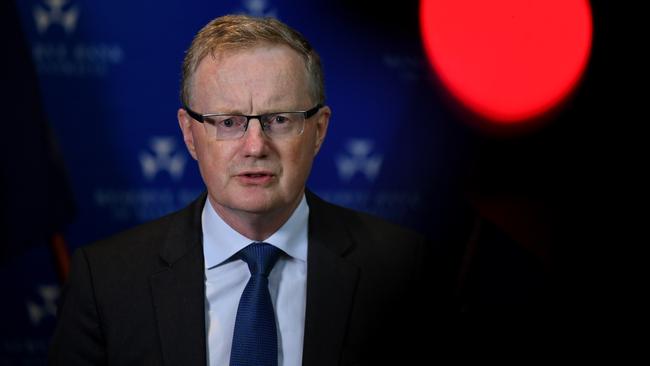RBA chief Philip Lowe dents investors’ hopes for quick recovery
RBA governor Philip Lowe’s ‘sobering picture’ of the economy triggered the biggest two-day fall in Australian shares on Tuesday.

The biggest two-day fall in Australian shares in the past five weeks has highlighted their vulnerability despite a strong rise in recent weeks, after an update from Reserve Bank governor Philip Lowe warned upcoming economic data “will present a very sobering picture” of the state of the economy.
The S&P/ASX 200 index dived 2.5 per cent to 5221.3 points on Tuesday to be down 5 per cent so far this week, while the dollar fell for a second-day running, hitting a three-day low of US62.84c.
After the benchmark index plunged 39 per cent from a record high of 7197.2 in February to a seven-year low of 4402.5 in March, amid unprecedented coronavirus lockdowns, it had bounced 26 per cent in the next four weeks amid unprecedented monetary and fiscal stimulus and expectations of an economic restart. At the same time, the dollar bounced 17 per cent to US64.45c after hitting an 18-year low of US55.1c.
But the rally in shares and the dollar has lost momentum, with oil prices plunging to 20-year lows as storage capacity falls amid a massive destruction of demand, the global economy cratering and investors focusing on the risk of renewed outbreaks stemming from attempts to normalise economic activity without a vaccine, herd immunity or widespread testing.
The sharemarket was also dented by US President Donald Trump’s decision to temporarily suspended US immigration even as he pushed to restart the US economy, and by Dr Lowe’s frank assessment of the economic outlook, the risks associated with lessening restrictions and the potential longer-term effects of the global coronavirus crisis on consumer and business sentiment.
Dr Lowe’s base case is that the economy shrinks 10 per cent and total hours worked falls 20 per cent in the first half, the unemployment rate hits 10 per cent by June, and growth falls 6 per cent this year.
With the optimistic assumption that restrictions start easing from mid-year and are mostly removed by late in the year — except for international travel — Dr Lowe expects the economy to “begin its bounce back” in the September quarter, with very strong growth of 6-7 per cent next year.
But he cautioned there was “quite a lot of uncertainty” about the recovery because it depends not only on when the restrictions are lifted, but also on “how people feel about the future”.
In that regard, he warned the unemployment rate is likely to stay above 6 per cent for two years.
“Whatever the timing of the recovery, when it does come, we should not be expecting that we will return quickly to business as usual,” Dr Lowe said. “Rather, the twin health and economic emergencies that we are experiencing now will cast a shadow over our economy for some time to come.”
He said it was “highly probable that the severe shocks we are now experiencing will change the mindsets of some people and businesses” and “even after the restrictions are lifted, it is likely that some of the precautionary behaviour will persist, and in the months ahead, we are likely to lose some businesses, despite best efforts, and some of these businesses will not reopen.”
Dr Lowe also cautioned that “there will be a higher level of debt and some households might revaluate the risks of having highly-leveraged balance sheets.
“It also probable that there will be structural changes in the economy,” he added. “Some of these changes will probably stay with us, requiring a rethinking of business models. So the crisis will have reverberations through our economy for some time to come.”
The property market faced a “difficult period” and it was “entirely appropriate” for banks to reduce their dividends, he said.
And he didn’t leave any hope of the RBA providing liquidity support for super funds facing “quite large” withdrawals of up to 25 per cent of their assets, under the early withdrawal scheme.
“The liquidity withdrawal from the super fund industry as a whole is perfectly manageable,” he said. “For some funds, the withdrawals are going to be quite large and those funds will have to shrink. But these funds have now had a month to get ready and they have further time before those withdrawals will take place.”
It came as Macquarie’s Australian equity strategist Matt Brooks warned that high valuations would “likely constrain further upside” in the sharemarket. “Policy stimulus reduced uncertainty, but until we see how the economy ramps up after the shutdown ends, earnings visibility remains low,” he said. “You will know the outlook is improving when companies reinstate guidance.”
Robert Luciano, executive chairman of $3.2bn listed hedge and long-term fund VGI Partners, said he was “deeply concerned” about the outlook for equity markets even as they had “rallied hard off their March lows”.
“We don’t yet know what shape the consumer or economy will be in when this situation settles, but there is no basis for optimism in the data to date,” he said.
“The range of potential scenarios for how things unfold from here — coupled with the market’s apparent confidence that the recovery will be V-shaped — is creating fresh challenges for how we position our portfolios.”




To join the conversation, please log in. Don't have an account? Register
Join the conversation, you are commenting as Logout